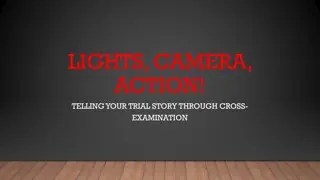
In and Out Line Monitoring System for Volleyball by Kelley White
Develop a system to determine if a volleyball lands on the line, ensuring fair play. The project involves sensors, a microprocessor, and LED indicators for accurate ball contact detection. Testing phases include electrical engineering labs and on-court trials with the Union College Volleyball team. Scheduled tasks include testing, ordering parts, detailed design descriptions, and algorithm development towards the final project completion.
Uploaded on | 1 Views
Download Presentation

Please find below an Image/Link to download the presentation.
The content on the website is provided AS IS for your information and personal use only. It may not be sold, licensed, or shared on other websites without obtaining consent from the author. If you encounter any issues during the download, it is possible that the publisher has removed the file from their server.
You are allowed to download the files provided on this website for personal or commercial use, subject to the condition that they are used lawfully. All files are the property of their respective owners.
The content on the website is provided AS IS for your information and personal use only. It may not be sold, licensed, or shared on other websites without obtaining consent from the author.
E N D
Presentation Transcript
In and Out Line Monitoring System for Volleyball Kelley White Advisor: Professor Buma
What problem will this project solve? Goals?: A line judge determines if a ball lands in or outside the court There is a need to ensure good calls and a fair game for players and coaches Develop a system that can determine if a ball lands on the line
Specifications: The prototype will be a 6 foot portion of the end line Battery powered and rechargeable (able to last a 10 hour tournament day) Green light indicating ball contact Simple installation with overlying tape over existing line
Block Diagram microcontroller Input from sensor Indicator (LED)
Design: Sensors 9 force sensitive resistors (FSR s) Connected to microprocessor with thin wire
Design: Microprocessor Arduino- receives voltage signal from one or multiple of the FSR s Output LED light at Arduino for ball contact and no light for foot contact
Testing Initial testing with the force plate in Butterfield Testing with FSR s in electrical engineering labs Final testing on court with Union College Volleyball team
Project Schedule: Fall term: - Testing with FSR s and adjust design if necessary - Finalize and order all parts - Detailed design description - Update web page - Final design report Winter Term: - Algorithm development - Continued development with further testing - Final project complete with desired testing outcomes - Final project report
Appendix Budget:
Thickness: Basic scotch tape: 0.058 mm Wires: 0.2546 mm FSR s: 0.40 mm Max total thickness: 0.40+0.058= 0.458 mm *will be negligible to players
FSRs .5 diameter $6.95 1.75x1.5 $7.95 .16 diameter $5.95
Arduino MEGA 2560: 1. Pins: Need at least 11 input pins (9 with room) there are 16 input pins 2. Memory rate: Unneeded. Processing real time data to make the output decision. Not storing any outputs/inputs. 256KB 3. Sampling rate: 10 samples a second worked well for differentiating force, but 50 samples a second would ensure accuracy 16MHz 4. Battery life will need to be chosen after testing with the FSR s and computing the maximum power dissipation in the lab Analog/digital MUX - 9 input sensors for only 6 feet & need a way to look at all sensors if the project is expanded to the whole perimeter






















